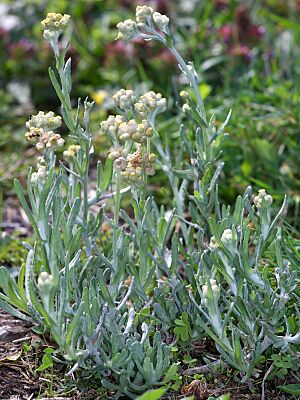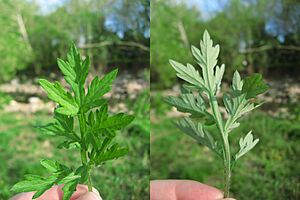Kusa mochi facts for kids
 |
|
| Alternative names | Yomogi mochi |
|---|---|
| Type | Wagashi |
| Place of origin | Japan |
| Main ingredients | Mochi, yomogi leaf; red bean paste |
| 150 (for 50g) kcal | |
Kusa mochi (pronounced Koo-sah MOH-chee) is a special Japanese sweet. Its name means "herb mochi." It's also called yomogi mochi. This treat is made from soft, chewy mochi (rice cake) mixed with leaves of a plant called Japanese mugwort. This plant is also known as yomogi.
When Japanese mugwort is mixed into the mochi, it gives kusa mochi a bright green color. The more mugwort used, the greener the mochi becomes. Kusa mochi is not just a tasty snack; it's also known for its health benefits!
History of Kusa Mochi
The idea of adding herbs to mochi came from China. Old Japanese writings show that important people in the Heian era (around 794 to 1185 AD) were already enjoying kusa mochi.
Before the Heian era, kusa mochi was made with a different plant called Jersey cudweed. But during the Heian era, people started using Japanese mugwort instead. This was because they discovered that Japanese mugwort could help with health and was thought to bring good luck.
Another reason for the change was the name of Jersey cudweed. In Japanese, it's called Haha-ko-gusa, which means "mother-and-child grass." Kusa mochi was often eaten to wish for the health of mothers and their children. So, people thought it might be bad luck to mix "mother-and-child grass" into the mochi itself.
Since the Edo era (1603 to 1868 AD), kusa mochi has been used as an offering for Hinamatsuri, also known as the Girl's Festival. It was chosen because its bright green color represents fresh new growth in spring. Also, the strong, healthy nature of Japanese mugwort made it a symbol of good health and a long life.
Kusa Mochi as a Healthy Food
For a very long time, people have believed that food and medicine are connected. Japanese mugwort, the main ingredient in kusa mochi, has been used as a medicine for at least 2,500 years.
Ancient Japanese texts say that Japanese mugwort can help stop bleeding, treat upset stomachs, and even help prevent miscarriages. These uses are still recognized today. Japanese mugwort is sometimes called "the queen of herbs" because it has many good things for your body.
Some of the helpful parts of Japanese mugwort include dietary fiber, chlorophyll, vitamin B1, and vitamin B2. These can help with digestion, improve your gut health, and act as antioxidants. Antioxidants help protect your body's cells.
Research from a center in Hokkaido, Japan, suggests that Japanese mugwort can also improve blood flow. It is thought to help widen blood vessels, which can be good for people with poor circulation.
It's important to know that Japanese mugwort is part of the asteraceae plant family. Some people might be allergic to plants in this family.
See also
 In Spanish: Kusa mochi para niños
In Spanish: Kusa mochi para niños



